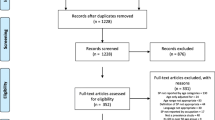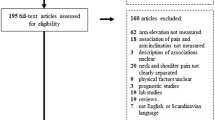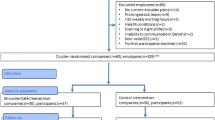Abstract
The main objective of this study is to update the evidence related to the effectiveness of exercise and ergonomic interventions in the perception of shoulder pain intensity in workers considering the shoulder pain intensity and the minimum clinically important change in the analysis. The bibliographic search was conducted in seven databases (Cochrane, EMBASE, SciELO, PubMed, PEDro, Web of Science and Scopus) from March to April 2019. The study selection included randomized controlled trials (RCTs) involving workers with shoulder pain who underwent physical exercises, ergonomics, and combined interventions. To analyze the RCTs, the intensity of pain was divided into two subgroups < 3 and ≥ 3 (0–10 points scale). A total of 27 RCTs were included in the qualitative synthesis considering the perception scales of shoulder pain intensity and the PEDro scale score of assessment of RCTs quality and risk of bias. Within these, seven RCTs were included in the quantitative synthesis. The overall effectiveness of interventions was calculated using a meta-analysis method, and the associated measurement used as a mean difference. The meta-analysis revealed that exercise interventions in workers with shoulder pain > 3 presented a minimally clincially important difference (MCID), but with no difference in workers with pain < 3. The interventions with exercise in workers with pain ≥ 3 at baseline reported a beneficial effect in reducing shoulder pain intensity, and a MCID. However, there was no significant difference for workers with pain < 3 and the effects of ergonomic interventions are still uncertain to reduce shoulder pain in workers.



Similar content being viewed by others
References
Guo HR, Chang YC, Yeh WY, Chen CW, Guo YL. Prevalence of musculoskeletal disorder among workers in Taiwan: a nationwide study. J Occup Health. 2004;46:26–36.
Whysall Z, Bowden J, Hewitt M. Sickness presenteeism: measurement and management challenges. Ergonomics. 2018;61:341–354.
Greving K, Dorrestijn O, Winters JC, Groenhof F, Van Der Meer K, Stevens M, et al. Incidence, prevalence, and consultation rates of shoulder complaints in general practice. Scand J Rheumatol. 2012;41:150–155.
Da Costa JT, Baptista JS, Vaz M. Incidence and prevalence of upper-limb work related musculoskeletal disorders: a systematic review. Work. 2015;51:635–644.
Linaker CH, Walker-Bone K. Soulder disorder and occupation. Ecol Lett. 2016;33:1684–1695.
Da Costa BR, Vieira ER. Risk factors for work-related musculoskeletal disorders: a systematic review of recent longitudinal studies. Am J Ind Med. 2010;53:285–323.
Mulimani P, Hoe VC, Hayes MJ, Idiculla JJ, Abas AB, Karanth L. Ergonomic interventions for preventing musculoskeletal disorders in dental care practitioners. Cochrane database Syst Rev. 2018;10:CD011261.
Geneen LJ, Moore RA, Clarke C, Martin D, Colvin LA, Smith BH. Physical activity and exercise for chronic pain in adults: an overview of Cochrane Reviews. Cochrane Database Syst Rev. 2017;14:35–39.
Verhagen AP, Bierma-Zeinstra SM, Burdorf A, Stynes SM, de Vet HC, Koes BW. Conservative interventions for treating work-related complaints of the arm, neck or shoulder in adults. Cochrane Database Syst Rev. 2013;12:8742.
Miyamoto GC, Lin CWC, Cabral CMN, Van Dongen JM, Van Tulder MW. Cost-effectiveness of exercise therapy in the treatment of non-specific neck pain and low back pain: a systematic review with meta-analysis. Br J Sports Med. 2019;53:172–181.
Niemeijer A, Lund H, Stafne SN, Ipsen T, Goldschmidt CL, Jørgensen CT, et al. Adverse events of exercise therapy in randomised controlled trials: a systematic review and meta-analysis. Br J Sports Med. 2019;54:1073.
Lowry VV, Desjardins-Charbonneau A, Roy J-SS, Dionne CE, Frémont P, MacDermid JC, et al. Efficacy of workplace interventions for shoulder pain: a systematic review and meta-analysis. J Rehabil Med. 2017;49:529–542.
Boonstra AM, Stewart RE, Köke AJA, Oosterwijk RFA, Swaan JL, Schreurs KMG, et al. Cut-off points for mild, moderate, and severe pain on the numeric rating scale for pain in patients with chronic musculoskeletal pain: variability and influence of sex and catastrophizing. Front Psychol. 2016;7:1–9.
Liberati A, Altman DG, Tetzlaff J, Mulrow C, Gøtzsche PC, Ioannidis JPA, et al. The PRISMA statement for reporting systematic reviews and meta-analyses of studies that evaluate health care interventions: explanation and elaboration. PLoS Med. 2009;6:e1000100.
Macedo LG, Elkins MR, Maher CG, Moseley AM, Herbert RD, Sherrington C. There was evidence of convergent and construct validity of physiotherapy evidence database quality scale for physiotherapy trials. J Clin Epidemiol. 2010;63:920–925.
Maher CG, Sherrington C, Herbert RD, Moseley AM, Elkins M. Reliability of the PEDro scale for rating quality of randomized controlled trials. Phys Ther. 2003;83:713–721.
Schünemann H, Brożek J, Guyatt G, Oxman A. GRADE handbook for grading quality of evidence and strength of recommendations. Gr: GRADE Work; 2013.
Zebis MK, Andersen LL, Pedersen MMTMM, Mortensen P, Andersen CH, Pedersen MMTMM, et al. Implementation of neck/shoulder exercises for pain relief among industrial workers: a randomized controlled trial. BMC Musculoskelet Disord. 2011;12:205–213.
Gram B, Andersen C, Zebis MK, Bredahl T, Pedersen MT, Mortensen OS, et al. Effect of training supervision on effectiveness of strength training for reducing neck/shoulder pain and headache in office workers: cluster randomized controlled trial. Biomed Res Int. 2014;2014:1–9.
Tashjian RZ, Deloach J, Porucznik CA, Powell AP. Minimal clinically important differences (MCID) and patient acceptable symptomatic state (PASS) for visual analog scales (VAS) measuring pain in patients treated for rotator cuff disease. J Shoulder Elb Surg. 2009;18:927–932.
Andersen CH, Andersen LL, Gram B, Pedersen MT, Mortensen OS, Zebis MK, et al. Influence of frequency and duration of strength training for effective management of neck and shoulder pain: a randomised controlled trial. Br J Sports Med. 2012;46:1004–1100.
Dalager T, Bredahl TGVV, Pedersen MT, Boyle E, Andersen LL, Sjøgaard G. Does training frequency and supervision affect compliance, performance and muscular health? A cluster randomized controlled trial. Man Ther. 2015;20:657–665.
Pedersen MT, Andersen CH, Zebis MK, Sjogaard G, Andersen LL, Sjøgaard G, et al. Implementation of specific strength training among industrial laboratory technicians: long-term effects on back, neck and upper extremity pain. BMC Musculoskelet Disord. 2013;14:287.
Andersen LL, Jørgensen MB, Blangsted AK, Pedersen MT, Hansen EA, Sjøgaard G. A randomized controlled intervention trial to relieve and prevent neck/shoulder pain. Med Sci Sports Exerc. 2008;40:983–990.
Andersen LL, Christensen KB, Holtermann A, Poulsen OM, Sjøgaard G, Pedersen MT, et al. Effect of physical exercise interventions on musculoskeletal pain in all body regions among office workers: a one-year randomized controlled trial. Man Ther. 2010;15:100–104.
Blangsted AK, Søgaard K, Hansen EA, Hannerz H, Sjøgaard G. One-year randomized controlled trial with different physical-activity programs to reduce musculoskeletal symptoms in the neck and shoulders among office workers. Scand J Work Environ Heal Suppl. 2008;34:55–65.
Tsang SMHH, So BCLL, Lau RWLL, Dai J, Szeto GPYY. Comparing the effectiveness of integrating ergonomics and motor control to conventional treatment for pain and functional recovery of work-related neck–shoulder pain: a randomized trial. Eur J Pain. 2019;23:1141–1152.
Tsang SMH, So BCL, Lau RWL, Dai J, Szeto GPY. Effects of combining ergonomic interventions and motor control exercises on muscle activity and kinematics in people with work-related neck–shoulder pain. Eur J Appl Physiol. 2018;118:751–765.
Rasotto C, Bergamin M, Simonetti A, Maso S, Bartolucci GB, Ermolao A, et al. Tailored exercise program reduces symptoms of upper limb work-related musculoskeletal disorders in a group of metalworkers: a randomized controlled trial. Man Ther. 2014;20:56–62.
Rasotto C, Bergamin M, Sieverdes JC, Gobbo S, Alberton CL, Neunhaeuserer D, et al. A tailored workplace exercise program for women at risk for neck and upper limb musculoskeletal disorders: a randomized controlled trial. J Occup Environ Med. 2015;57:178–183.
Andersen LL, Saervoll CA, Mortensen OS, Poulsen OM, Hannerz H, Zebis MK. Effectiveness of small daily amounts of progressive resistance training for frequent neck/shoulder pain: randomised controlled trial. Pain. 2011;152:440–446.
Jay K, Brandt M, Hansen K, Sundstrup E, Jakobsen MD, Schraefel MC, et al. Effect of individually tailored biopsychosocial workplace interventions on chronic musculoskeletal pain and stress among laboratory technicians: randomized controlled trial. Pain Phys. 2015;18:459–471.
Ma C, Szeto GP, Yan T, Wu S, Lin C, Li L. Comparing biofeedback with active exercise and passive treatment for the management of work-related neck and shoulder pain: a randomized controlled trial. Arch Phys Med Rehabil. 2011;92:849–858.
Conlon CF, Krause N, Rempel DM. A randomised controlled trial evaluating an alternative mouse and forearm support on upper body discomfort and musculoskeletal disorders among engineers. Occup Environ Med. 2008;65:311–318.
Voerman GE, Sandsjö L, Vollenbroek-Hutten MMR, Larsman P, Kadefors R, Hermens HJ. Effects of ambulant myofeedback training and ergonomic counselling in female computer workers with work-related neck-shoulder complaints: a randomized controlled trial. J Occup Rehabil. 2007;17:137–152.
Sundstrup E, Jakobsen MD, Andersen CH, Jay K, Persson R, Aagaard P, et al. Effect of two contrasting interventions on upper limb chronic pain and disability: a randomized controlled trial. Pain Phys. 2014;17:145–154.
Sjögren T, Nissinen KJ, Järvenpää SK, Ojanen MT, Vanharanta H, Mälkiä EA, et al. Effects of a workplace physical exercise intervention on the intensity of headache and neck and shoulder symptoms and upper extremity muscular strength of office workers: a cluster randomized controlled cross-over trial. Pain. 2005;116:119–128.
Murray M, Lange B, Nørnberg BR, Søgaard K, Sjøgaard G, Nornberg BR, et al. Self-administered physical exercise training as treatment of neck and shoulder pain among military helicopter pilots and crew: a randomized controlled trial. BMC Musculoskelet Disord. 2017;18:147.
Martins LV, Marziale MHP. Assessment of proprioceptive exercises in the treatment of rotator cuff disorders in nursing professionals: a randomized controlled clinical trial. Braz J Phys Ther. 2012;16:502–509.
Lundblad I, Elert J, Gerdle B. Randomized controlled trial of physiotherapy and Feldenkrais interventions in female workers with neck-shoulder complaints. J Occup Rehabil. 1999;9:179–194.
Lange B, Toft P, Myburgh C, Sjøgaard G. Effect of targeted strength, endurance, and coordination exercise on neck and shoulder pain among fighter pilots: a randomized-controlled trial. Clin J Pain. 2013;29:50–59.
Korshøj M, Birk Jørgensen M, Lidegaard M, Mortensen OS, Krustrup P, Holtermann A, et al. Decrease in musculoskeletal pain after 4 and 12 months of an aerobic exercise intervention: a worksite RCT among cleaners. Scand J Public Health. 2018;46:846–853.
Jakobsen MD, Sundstrup E, Brandt M, Andersen LL. Effect of physical exercise on musculoskeletal pain in multiple body regions among healthcare workers: secondary analysis of a cluster randomized controlled trial. Musculoskelet Sci Pract. 2018;34:89–96.
Andersen CH, Andersen LL, Zebis MK, Sjøgaard G. Effect of scapular function training on chronic pain in the neck/shoulder region: a randomized controlled trial. J Occup Rehabil. 2014;24:316–324.
Hagberg M, Harms-Ringdahl K, Nisell R, Hjelm EW, Wigaeus HE. Rehabilitation of neck-shoulder pain in women industrial workers: a randomized trial comparing isometric shoulder endurance training with isometric shoulder strength training. Arch Phys Med Rehabil. 2000;81:1051–1058.
Herbert R, Jamtvedt G, Hagen KB, Mead J. Practical evidence-based physiotherapy, pract evidence-based physiother. Amsterdam: Elsevier; 2011.
Moreira-Silva I, Teixeira PM, Santos R, Abreu S, Moreira C, Mota J. The effects of workplace physical activity programs on musculoskeletal pain: a systematic review and meta-analysis. Work Health Saf. 2016;64:210–222.
Naugle KM, Fillingim RB, Riley JL. A meta-analytic review of the hypoalgesic effects of exercise. J Pain. 2012;13:1139–1150.
Haik MN, Alburquerque-Sendín F, Moreira RFC, Pires ED, Camargo PR. Effectiveness of physical therapy treatment of clearly defined subacromial pain: a systematic review of randomised controlled trials. Br J Sports Med. 2016;50:1124–1134.
WHO. The burden of musculoskeletal conditions at the start of the new millennium. World Health Organ Technical Representation Series. Geneva: WHO; 2003.
Suni JH, Kolu P, Tokola K, Raitanen J, Rinne M, Taulaniemi A, et al. Effectiveness and cost-effectiveness of neuromuscular exercise and back care counseling in female healthcare workers with recurrent non-specific low back pain: a blinded four-arm randomized controlled trial. BMC Public Health. 2018;18:1–13.
Bevan S. Economic impact of musculoskeletal disorders (MSDs) on work in Europe. Best Pract Res Clin Rheumatol. 2015;29:356–373.
Søgaard K, Sjøgaard G. Physical activity as cause and cure of muscular pain: evidence of underlying mechanisms. Exerc Sport Sci Rev. 2017;45:136–145.
Bongers PM, Ijmker S, Van Den Heuvel S, Blatter BM. Epidemiology of work related neck and upper limb problems: psychosocial and personal risk factors (Part I) and effective interventions from a bio behavioural perspective (Part II). J Occup Rehabil. 2006;16:279–302.
Van Eerd D, Munhall C, Irvin E, Rempel D, Brewer S, van der Beek AJ, et al. Effectiveness of workplace interventions in the prevention of upper extremity musculoskeletal disorders and symptoms: an update of the evidence. Occup Environ Med. 2016;73:62–70.
Feuerstein M, Nicholas RA, Huang GD, Dimberg L, Ali D, Rogers H. Job stress management and ergonomic intervention for work-related upper extremity symptoms. Appl Ergon. 2004;35:565–574.
Author information
Authors and Affiliations
Corresponding author
Ethics declarations
Conflict of interest
Sol Patrícia Beltran Picón, Gabriel de Amorim Batista, Ana Carolina Rodarti Pitangui and Rodrigo Cappato de Araújo declare that they have no conflict of interest.
Additional information
Publisher's Note
Springer Nature remains neutral with regard to jurisdictional claims in published maps and institutional affiliations.
Rights and permissions
About this article
Cite this article
Picón, S.P.B., Batista, G.A., Pitangui, A.C.R. et al. Effects of Workplace-Based Intervention for Shoulder Pain: A Systematic Review and Meta-analysis. J Occup Rehabil 31, 243–262 (2021). https://doi.org/10.1007/s10926-020-09927-6
Accepted:
Published:
Issue Date:
DOI: https://doi.org/10.1007/s10926-020-09927-6




